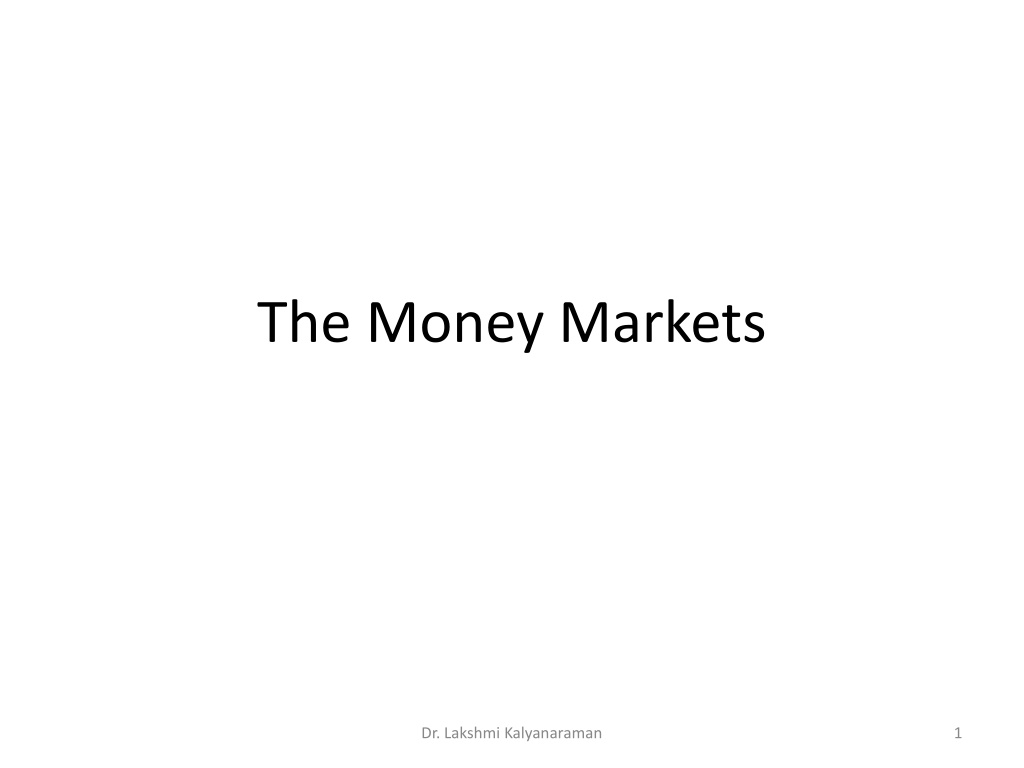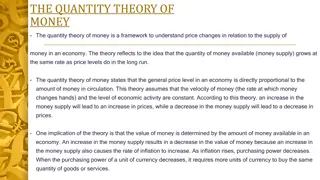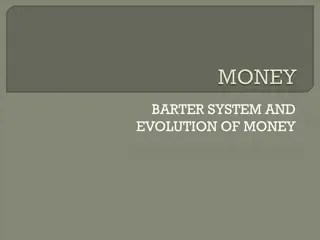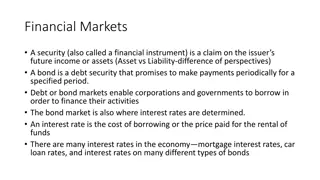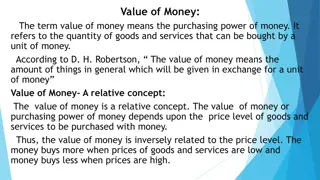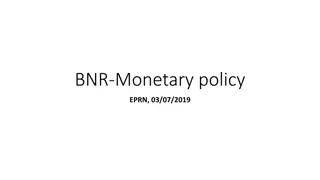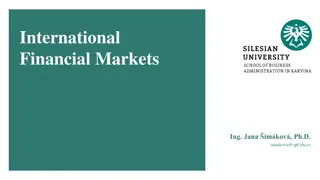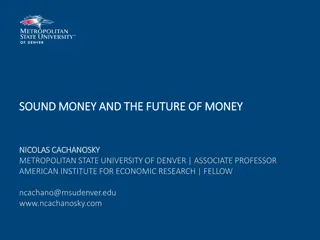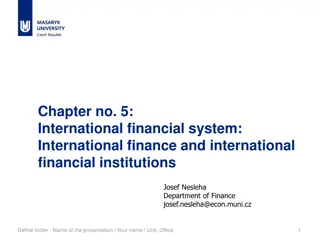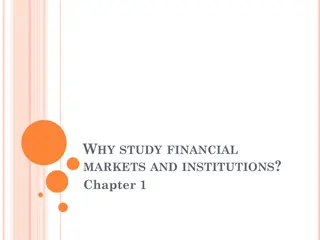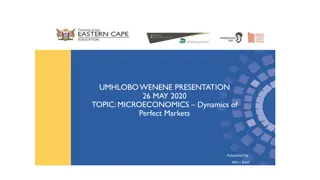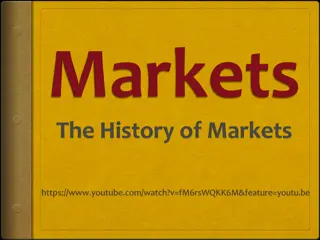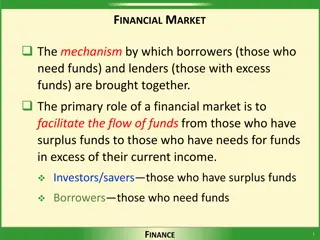Understanding Money Markets and Their Role in the Economy
Money markets are financial markets where short-term, low-risk securities are traded. Unlike banks, they offer distinct advantages such as liquidity, active secondary markets, and cost efficiency in providing short-term funds due to lower regulations. Despite the presence of banks, money markets play a crucial role in mediating between savers and borrowers and capturing economies of scale.
Download Presentation

Please find below an Image/Link to download the presentation.
The content on the website is provided AS IS for your information and personal use only. It may not be sold, licensed, or shared on other websites without obtaining consent from the author. Download presentation by click this link. If you encounter any issues during the download, it is possible that the publisher has removed the file from their server.
E N D
Presentation Transcript
The Money Markets Dr. Lakshmi Kalyanaraman 1
Characteristics Sold in large denominations Have low default risk Mature in one year or less from their original date of issue Do not take place in any one particular location Trades usually over phone and completed electronically Dr. Lakshmi Kalyanaraman 2
Characteristics Active secondary market Wholesale markets Dr. Lakshmi Kalyanaraman 3
Why do we need money markets? In unregulated world, money markets are not needed Why? Dr. Lakshmi Kalyanaraman 4
Banks Provide short-term loans Accept short-term deposits Have an efficiency advantage in gathering information Should eliminate the need for money markets Dr. Lakshmi Kalyanaraman 5
Banks Enjoy continuing relationship with customers Enjoy efficiency advantage in gathering information Evaluation of each borrower every time a new security is offered is easier for banks Should be able to offer loans more cheaply in diversified markets Should eliminate the need for money markets Dr. Lakshmi Kalyanaraman 6
Banks Short term securities offered for sale in the money markets are neither as liquid nor as safe as deposits placed in banks and thrifts Exist primarily to mediate the asymmetric information problem between saver-lenders and borrower-spenders Capture economies of scale while providing this service Dr. Lakshmi Kalyanaraman 7
Why do money markets exist? Where asymmetric information problem is not severe, the money markets have a distinct cost advantage over banks in providing short- term funds How? Dr. Lakshmi Kalyanaraman 8
Banks Subject to more regulations and governmental costs than are the money markets Don t invest 100% of their deposits Put aside a portion of their deposits in the form of reserves that are held without interest at the Central Bank Must pay less interest rate to depositors than if full deposit could be invested Dr. Lakshmi Kalyanaraman 9
Banks Interest rate regulations existed historically to reduce competition among banks Before it was repelled, money markets were established Dr. Lakshmi Kalyanaraman 10
Money markets However, cost structure of banking industry makes it unable to compete effectively in the market for short-term funds against less restricted money markets Dr. Lakshmi Kalyanaraman 11
Purpose of money markets Cash inflows and outflows are rarely synchronized Ideal for firm or financial institution to warehouse surplus funds until they are needed Provide low-cost source of funds for firms, the government, and intermediaries that need a short-term infusion of funds Dr. Lakshmi Kalyanaraman 12
Participants of money markets Treasury department: Always a demander of money market funds and never a supplier Issues treasury bills to raise funds until tax revenues are received Dr. Lakshmi Kalyanaraman 13
Participants of money markets Federal Reserve System: Treasury s agent for the distribution of all government securities Holds vast quantities of treasury securities Sells treasury bills if money supply should be reduced Buys treasury bills if money supply should be expanded Dr. Lakshmi Kalyanaraman 14
Participants of money markets Commercial Banks: Buy treasury securities Issue negotiable certificates of deposit, banker s acceptances, federal funds, and repurchase agreements Offer individual investor accounts that invest in money market securities Dr. Lakshmi Kalyanaraman 15
Participants of money markets Businesses: Buy and sell various short-term securities as a regular part of their cash management Dr. Lakshmi Kalyanaraman 16
Participants of money markets Investment companies Finance companies (commercial leasing companies) Insurance companies Pension funds Individuals Money market mutual funds Dr. Lakshmi Kalyanaraman 17
Money market instruments Dr. Lakshmi Kalyanaraman 18
Treasury bills Most liquid Discount securities zero default risk Inflation risk low because of short maturity Market is deep and liquid Dr. Lakshmi Kalyanaraman 19
Treasury bills Deep market: many different buyers and sellers Liquid market: securities can be bought and sold quickly and with low transaction costs Investors in markets that are deep and liquid have little risk as they can buy and sell securities when they want Dr. Lakshmi Kalyanaraman 20
Discounting the price of treasury securities to pay interest Dr. Lakshmi Kalyanaraman 21
Discounting Most money market securities do not pay interest Investor pays less for the security than it will be worth when it matures and the increase in price provides a return Dr. Lakshmi Kalyanaraman 22
Annualized discount rate calculation ?????????=? ? 360 ? ? ?????????= annualized discount rate % P = Purchase price F = Face or maturity value n = Number of days until maturity Dr. Lakshmi Kalyanaraman 23
Investment rate calculation What investor earns ? ? ? 365 ???????????= ? Dr. Lakshmi Kalyanaraman 24
Federal funds Short-term funds transferred (loaned or borrowed) between financial institutions usually for a period of one day Banks with excess reserves loan them to banks that need them Dr. Lakshmi Kalyanaraman 25
Repurchase agreements Nonbanks participate A firm can sell treasury securities in a repurchase agreement whereby the firm agrees to buy back the securities at a specified future date Collateralized with treasury securities Carry low risk and hence low interest rate Dr. Lakshmi Kalyanaraman 26
Negotiable certificates of deposit Bank issued security that documents a deposit Specifies the interest rate and the maturity date Term security Bearer instrument Dr. Lakshmi Kalyanaraman 27
Commercial paper Unsecured promissory notes issued by corporations Normally mature in 270 days Only largest and most creditworthy corporations issue Interest rate the corporation is charged reflects the firm s level of risk Dr. Lakshmi Kalyanaraman 28
Bankers acceptances An order to pay a specified amount of money to the bearer on a given date International trade Dr. Lakshmi Kalyanaraman 29
Eurodollars Dollar-denominated deposits at foreign banks or foreign branches of American banks Deposits of large sums, time deposits of less than 6 months Eurodollar CD liability of a non-US branch of a bank Less liquid and more risky than domestic CDs and offer higher yields Dr. Lakshmi Kalyanaraman 30
Interest rates All the money market instruments move closely as all have low risk and short term Deep markets and priced competitively Close substitutes Dr. Lakshmi Kalyanaraman 31
Liquidity How quickly, easily and cheaply security can be converted into cash Depth of the secondary market is the determinant Treasury bills are most liquid Commercial paper are least liquid Money market mutual funds provide liquidity intervention Dr. Lakshmi Kalyanaraman 32
Valuation of money market securities PV = FV/(1+i)^n Dr. Lakshmi Kalyanaraman 33
